A Comparative Study on the Electrical and Piezoresistive Sensing Characteristics of GFRP and CFRP Composites with Hybridized Incorporation of Carbon Nanotubes, Graphenes, Carbon Nanofibers, and Graphite Nanoplatelets
Abstract
:1. Introduction
- (1)
- Different combinations of hybridized carbon nanomaterials were dispersed in an epoxy resin and applied onto glass-fiber- or carbon-fiber-woven fabrics to form the CNM-incorporated carbon-fiber-reinforced plastic (CFRP) or glass-fiber-reinforced plastic (GFRP) composites.
- (2)
- The electrical properties were assessed using the two-probe method, and the piezoresistive sensing characteristics were examined by applying repeated tensile loads and synchronously monitoring changes in electrical resistance/stress.
- (3)
- The piezoresistive sensing characteristics were assessed in terms of gauge factor, peak shift, and R-squared values.
2. Materials and Methods
2.1. Materials
2.2. Mix Proportions
2.3. Sample Preparation
3. Test Methods
3.1. Electrical Resistance and Conductivity Test
3.2. Piezoresistive Sensing Performance Test
4. Results
4.1. Electrical Properties
4.2. Piezoresistive Responses of the Fabricated FRP Composites
4.3. Comparison of the Sensing Characteristics in Terms of the Average Maximum Electrical Resistance Change Rate and Gauge Factor
4.4. Comparison of Sensing Characteristics in Terms of Peak Shift
4.5. Comparison of the Sensing Characteristics in Terms of R-Squared
5. Conclusions
- (1)
- In the electrical property results, it was found that the GFRP samples with just CNTs or both CNTs and graphene showed much higher electrical conductivities than the other composite samples, and the percolation threshold was in the range of 0 to 1.5 wt.% of incorporated CNMs. Furthermore, the CFRP samples exhibited high electrical conductivity values, such as 8933 S/m, even without CNMs and marginal variations in CNM addition.
- (2)
- After evaluating the piezoresistive sensing characteristics, it was found that the CNT–CNF GFRP composites exhibited the highest average maximum electrical resistance change rate and gauge factor values, followed by the CNT–graphene and CNT-only GFRP composites. These results were explained by the excluded volume theory, which yielded a higher excluded volume in the order of CNFs, graphene, and CNTs.
- (3)
- All 3%-CNM-incorporated CFRP composites showed deterioration in terms of gauge factor, and this was ascribed to the adequately electrically conductive pathways formed by the carbon fibers and the relatively high CNM content ratio.
- (4)
- All peak shifts of the CNM-embedded GFRP samples were in the range of 3.46 to 3.52%, signifying that the electrical resistance change rates of the composites were correlated to the applied loads. However, all CNM-incorporated CFRP composites had relatively large peak shifts, ranging from 10 to 73%.
- (5)
- The fabricated CNM-incorporated GFRP samples showed more stable and reliable electrical resistance change rates, which accounted for their higher R-squared values, compared to the fabricated CNM-incorporated CFRP samples. Furthermore, the CNT–graphene GFRP composites exhibited the best R-squared value. Because the CNT–graphene GFRP composites showed better peak shift and gauge factor performance, these composites were the most feasible for use as FRP composite sensors.
- (6)
- Although a synergistic effect was unclear in the electrical conductivity results, synergistic effects were pronounced in the CNT–CNF GFRP composites and CNT–graphene GFRP composites investigated in terms of the gauge factor and the R-squared value, respectively.
Author Contributions
Funding
Informed Consent Statement
Acknowledgments
Conflicts of Interest
References
- Turner, J.H. Sociological Theory Today. In Handbook of Sociological Theory; Springer: Cham, Switzerland, 2001; pp. 1–17. [Google Scholar]
- Chang, P.C.; Flatau, A.; Liu, S.C. Review Paper: Health Monitoring of Civil Infrastructure. Struct. Health Monit. 2003, 2, 257–267. [Google Scholar] [CrossRef]
- Gillott, J.E. Effect of deicing agents and sulphate solutions on concrete aggregate. Q. J. Eng. Geol. Hydrogeol. 1978, 11, 177–192. [Google Scholar] [CrossRef]
- Catbas, F.N.; Susoy, M.; Frangopol, D.M. Structural health monitoring and reliability estimation: Long span truss bridge application with environmental monitoring data. Eng. Struct. 2008, 30, 2347–2359. [Google Scholar] [CrossRef]
- Ellingwood, B.R. Risk-informed condition assessment of civil infrastructure: State of practice and research issues. Struct. Infrastruct. Eng. 2005, 1, 7–18. [Google Scholar] [CrossRef]
- Loyola, B.R.; Loh, K.J.; La Saponara, V. Static and dynamic strain monitoring of GFRP composites using carbon nanotube thin films. Proc. SPIE 2011, 7981, 798108. [Google Scholar] [CrossRef]
- Chong, K.P.; Carino, N.J.; Washer, G. Health monitoring of civil infrastructures. Smart Mater. Struct. 2003, 12, 483–493. [Google Scholar] [CrossRef]
- Zhou, X.; Luo, H.; Zhang, Y.; Wang, H.; Lin, Y.; Zhao, G.; Yi, G.; Yuan, S.; Zhu, Z. Tunable water sensitive polymeric composites with synergistic graphene and carbon nanotubes. Mater. Lett. 2017, 199, 160–163. [Google Scholar] [CrossRef]
- Kim, Y.-J.; Cha, J.Y.; Ham, H.; Huh, H.; So, D.-S.; Kang, I. Preparation of piezoresistive nano smart hybrid material based on graphene. Curr. Appl. Phys. 2011, 11, S350–S352. [Google Scholar] [CrossRef]
- Aguilar-Bolados, H.; Yazdani-Pedram, M.; Contreras-Cid, A.; López-Manchado, M.; May-Pat, A.; Avilés, F. Influence of the morphology of carbon nanostructures on the piezoresistivity of hybrid natural rubber nanocomposites. Compos. Part B Eng. 2017, 109, 147–154. [Google Scholar] [CrossRef]
- Punetha, V.D.; Rana, S.; Yoo, H.J.; Chaurasia, A.; McLeskey, J.T.; Ramasamy, M.S.; Sahoo, N.G.; Cho, J.W. Functionalization of carbon nanomaterials for advanced polymer nanocomposites: A comparison study between CNT and graphene. Prog. Polym. Sci. 2017, 67, 1–47. [Google Scholar] [CrossRef]
- Sierra-Chi, C.; Aguilar-Bolados, H.; López-Manchado, M.; Verdejo, R.; Cauich-Rodríguez, J.; Avilés, F. Flexural electromechanical properties of multilayer graphene sheet/carbon nanotube/vinyl ester hybrid nanocomposites. Compos. Sci. Technol. 2020, 194, 108164. [Google Scholar] [CrossRef]
- Ke, K.; Yue, L.; Shao, H.; Yang, M.-B.; Yang, W.; Manas-Zloczower, I. Boosting electrical and piezoresistive properties of polymer nanocomposites via hybrid carbon fillers: A review. Carbon 2021, 173, 1020–1040. [Google Scholar] [CrossRef]
- Jeong, C.; Park, Y.-B. Exfoliated Graphite Nanoplatelet-Carbon Nanotube Hybrid Composites for Compression Sensing. ACS Omega 2020, 5, 2630–2639. [Google Scholar] [CrossRef]
- Schumacher, T.; Thostenson, E.T. Development of structural carbon nanotube–based sensing composites for concrete structures. J. Intell. Mater. Syst. Struct. 2013, 25, 1331–1339. [Google Scholar] [CrossRef]
- Qin, W.; Chen, C.; Zhou, J.; Meng, J. Synergistic Effects of Graphene/Carbon Nanotubes Hybrid Coating on the Interfacial and Mechanical Properties of Fiber Composites. Materials 2020, 13, 1457. [Google Scholar] [CrossRef] [Green Version]
- Naeem, F.; Lee, H.; Kim, H.-K.; Nam, I. Flexural stress and crack sensing capabilities of MWNT/cement composites. Compos. Struct. 2017, 175, 86–100. [Google Scholar] [CrossRef]
- Yu, X.; Cheng, H.; Zhang, M.; Zhao, Y.; Qu, L.; Shi, G. Graphene-based smart materials. Nat. Rev. Mater. 2017, 2, 17046. [Google Scholar] [CrossRef]
- Boland, C.S.; Khan, U.; Ryan, G.; Barwich, S.; Charifou, R.; Harvey, A.; Backes, C.; Li, Z.; Ferreira, M.S.; Möbius, M.E.; et al. Sensitive electromechanical sensors using viscoelastic graphene-polymer nanocomposites. Science 2016, 354, 1257–1260. [Google Scholar] [CrossRef]
- Kumar, A.; Sharma, K.; Dixit, A.R. Carbon nanotube- and graphene-reinforced multiphase polymeric composites: Review on their properties and applications. J. Mater. Sci. 2020, 55, 2682–2724. [Google Scholar] [CrossRef]
- Pérez-Aranda, C.; Avilés, F. Electromechanical properties of carbon-nanostructured elastomeric composites measured by digital image correlation. Compos. Part C Open Access 2021, 5, 100161. [Google Scholar] [CrossRef]
- Wang, X.; Wang, J.; Biswas, S.; Kim, H.; Nam, I. Mechanical, Electrical, and Piezoresistive Sensing Characteristics of Epoxy-Based Composites Incorporating Hybridized Networks of Carbon Nanotubes, Graphene, Carbon Nanofibers, or Graphite Nanoplatelets. Sensors 2020, 20, 2094. [Google Scholar] [CrossRef] [Green Version]
- Avilés, F.; May-Pat, A.; López-Manchado, M.; Verdejo, R.; Bachmatiuk, A.; Rümmeli, M. A comparative study on the mechanical, electrical and piezoresistive properties of polymer composites using carbon nanostructures of different topology. Eur. Polym. J. 2018, 99, 394–402. [Google Scholar] [CrossRef]
- Nam, I.; Park, S.M.; Lee, H.; Zheng, L. Mechanical properties and piezoresistive sensing capabilities of FRP composites incorporating CNT fibers. Compos. Struct. 2017, 178, 1–8. [Google Scholar] [CrossRef]
- Krishnan, A.; Dujardin, E.; Ebbesen, T.W.; Yianilos, P.N.; Treacy, M.M.J. Young’s modulus of single-walled nanotubes. Phys. Rev. B Condens. Matter Mater. Phys. 1998, 58, 14013–14019. [Google Scholar] [CrossRef] [Green Version]
- Yu, M.-F.; Lourie, O.; Dyer, M.J.; Moloni, K.; Kelly, T.F.; Ruoff, R.S. Strength and Breaking Mechanism of Multiwalled Carbon Nanotubes Under Tensile Load. Science 2000, 287, 637–640. [Google Scholar] [CrossRef] [PubMed] [Green Version]
- Lee, C.; Wei, X.; Kysar, J.W.; Hone, J. Measurement of the Elastic Properties and Intrinsic Strength of Monolayer Graphene. Science 2008, 321, 385–388. [Google Scholar] [CrossRef]
- Yu, M.-F.; Files, B.S.; Arepalli, S.; Ruoff, R.S. Tensile Loading of Ropes of Single Wall Carbon Nanotubes and their Mechanical Properties. Phys. Rev. Lett. 2000, 84, 5552–5555. [Google Scholar] [CrossRef] [Green Version]
- Ebbesen, T.W.; Lezec, H.J.; Hiura, H.; Bennett, J.W.; Ghaemi, H.F.; Thio, T. Electrical conductivity of individual carbon nanotubes. Nature 1996, 382, 54–56. [Google Scholar] [CrossRef]
- Chen, J.-H.; Jang, C.; Xiao, S.; Ishigami, M.; Fuhrer, M.S. Intrinsic and extrinsic performance limits of graphene devices on SiO2. Nat. Nanotechnol. 2008, 3, 206–209. [Google Scholar] [CrossRef]
- Berber, S.; Kwon, Y.-K.; Tománek, D. Unusually high thermal conductivity of carbon nanotubes. Phys. Rev. Lett. 2000, 84, 4613. [Google Scholar] [CrossRef] [Green Version]
- Kim, P.; Shi, L.; Majumdar, A.; McEuen, P.L. Thermal Transport Measurements of Individual Multiwalled Nanotubes. Phys. Rev. Lett. 2001, 87, 215502. [Google Scholar] [CrossRef] [Green Version]
- Seol, J.H.; Jo, I.; Moore, A.L.; Lindsay, L.; Aitken, Z.H.; Pettes, M.T.; Li, X.; Yao, Z.; Huang, R.; Broido, D.; et al. Two-Dimensional Phonon Transport in Supported Graphene. Science 2010, 328, 213–216. [Google Scholar] [CrossRef] [Green Version]
- Thess, A.; Lee, R.; Nikolaev, P.; Dai, H.; Petit, P.; Robert, J.; Xu, C.; Lee, Y.H.; Kim, S.G.; Rinzler, A.G.; et al. Crystalline Ropes of Metallic Carbon Nanotubes. Science 1996, 273, 483–487. [Google Scholar] [CrossRef] [PubMed] [Green Version]
- Stankovich, S.; Dikin, D.A.; Piner, R.D.; Kohlhaas, K.A.; Kleinhammes, A.; Jia, Y.; Wu, Y.; Nguyen, S.; Ruoff, R.S. Synthesis of graphene-based nanosheets via chemical reduction of exfoliated graphite oxide. Carbon 2007, 45, 1558–1565. [Google Scholar] [CrossRef]
- Li, J.; Li, W.; Huang, W.; Zhang, G.; Sun, R.; Wong, C.-P. Fabrication of highly reinforced and compressible graphene/carbon nanotube hybrid foams via a facile self-assembly process for application as strain sensors and beyond. J. Mater. Chem. C 2017, 5, 2723–2730. [Google Scholar] [CrossRef]
- Li, W.; Dichiara, A.; Bai, J. Carbon nanotube–graphene nanoplatelet hybrids as high-performance multifunctional reinforcements in epoxy composites. Compos. Sci. Technol. 2013, 74, 221–227. [Google Scholar] [CrossRef]
- Zhao, H.; Bai, J. Highly Sensitive Piezo-Resistive Graphite Nanoplatelet–Carbon Nanotube Hybrids/Polydimethylsilicone Composites with Improved Conductive Network Construction. ACS Appl. Mater. Interfaces 2015, 7, 9652–9659. [Google Scholar] [CrossRef]
- Luo, S. Processing-Structure-Property Relationships of Carbon Nanotube and Nanoplatelet Enabled Piezoresistive Sensors. Ph.D. Thesis, Florida State University, Tallahassee, FL, USA, 2013. [Google Scholar]
- Nuli, K.C.; Fulmali, A.O.; Nagesh; Sen, B.; Mahato, K.K.; Prusty, R.K.; Ray, B.C. Synergetic Impact of Carbon Nanotube and/or Graphene Reinforcement on the Mechanical Performance of Glass Fiber/Epoxy Composite. Mater. Sci. Forum 2020, 978, 284–290. [Google Scholar] [CrossRef]
- Nam, I.; Souri, H.; Lee, H. Percolation threshold and piezoresistive response of multi-wall carbon nanotube/cement composites. Smart Struct. Syst. 2016, 18, 217–231. [Google Scholar] [CrossRef]
- Gonzalez-Dominguez, J.M.; Martinez-Rubi, Y.; Díez-Pascual, A.M.; Ansón-Casaos, A.; Gómez-Fatou, M.; Simard, B.; Martínez, M.T. Reactive fillers based on SWCNTs functionalized with matrix-based moieties for the production of epoxy composites with superior and tunable properties. Nanotechnology 2012, 23, 285702. [Google Scholar] [CrossRef] [Green Version]
- Jang, D.; Yoon, H.; Nam, I.; Lee, H. Effect of carbonyl iron powder incorporation on the piezoresistive sensing characteristics of CNT-based polymeric sensor. Compos. Struct. 2020, 244, 112260. [Google Scholar] [CrossRef]
- Wang, F.; Drzal, L.T.; Qin, Y.; Huang, Z. Size effect of graphene nanoplatelets on the morphology and mechanical behavior of glass fiber/epoxy composites. J. Mater. Sci. 2016, 51, 3337–3348. [Google Scholar] [CrossRef]
- Khan, J.B.; Smith, A.C.; Tuohy, P.M.; Gresil, M.; Soutis, C.; Lambourne, A. Experimental electrical characterisation of carbon fibre composites for use in future aircraft applications. IET Sci. Meas. Technol. 2019, 13, 1131–1138. [Google Scholar] [CrossRef] [Green Version]
- Avilés, F.; Oliva-Avilés, A.I.; Cen-Puc, M. Piezoresistivity, Strain, and Damage Self-Sensing of Polymer Composites Filled with Carbon Nanostructures. Adv. Eng. Mater. 2018, 20, 1701159. [Google Scholar] [CrossRef]
- Ferreira, A.; Cardoso, P.; Klosterman, D.; Covas, J.A.; Van Hattum, F.; Vaz, F.; Lanceros-Mendez, S. Effect of filler dispersion on the electromechanical response of epoxy/vapor-grown carbon nanofiber composites. Smart Mater. Struct. 2012, 21, 75008. [Google Scholar] [CrossRef]
- Kostopoulos, V.; Vavouliotis, A.; Karapappas, P.; Tsotra, P.; Paipetis, A. Damage Monitoring of Carbon Fiber Reinforced Laminates Using Resistance Measurements. Improving Sensitivity Using Carbon Nanotube Doped Epoxy Matrix System. J. Intell. Mater. Syst. Struct. 2009, 20, 1025–1034. [Google Scholar] [CrossRef]
- Philipse, A.P. The Random Contact Equation and Its Implications for (Colloidal) Rods in Packings, Suspensions, and Anisotropic Powders. Langmuir 1996, 12, 1127–1133. [Google Scholar] [CrossRef] [Green Version]
- Kim, H.-K.; Park, I.; Lee, H. Improved piezoresistive sensitivity and stability of CNT/cement mortar composites with low water–binder ratio. Compos. Struct. 2014, 116, 713–719. [Google Scholar] [CrossRef]
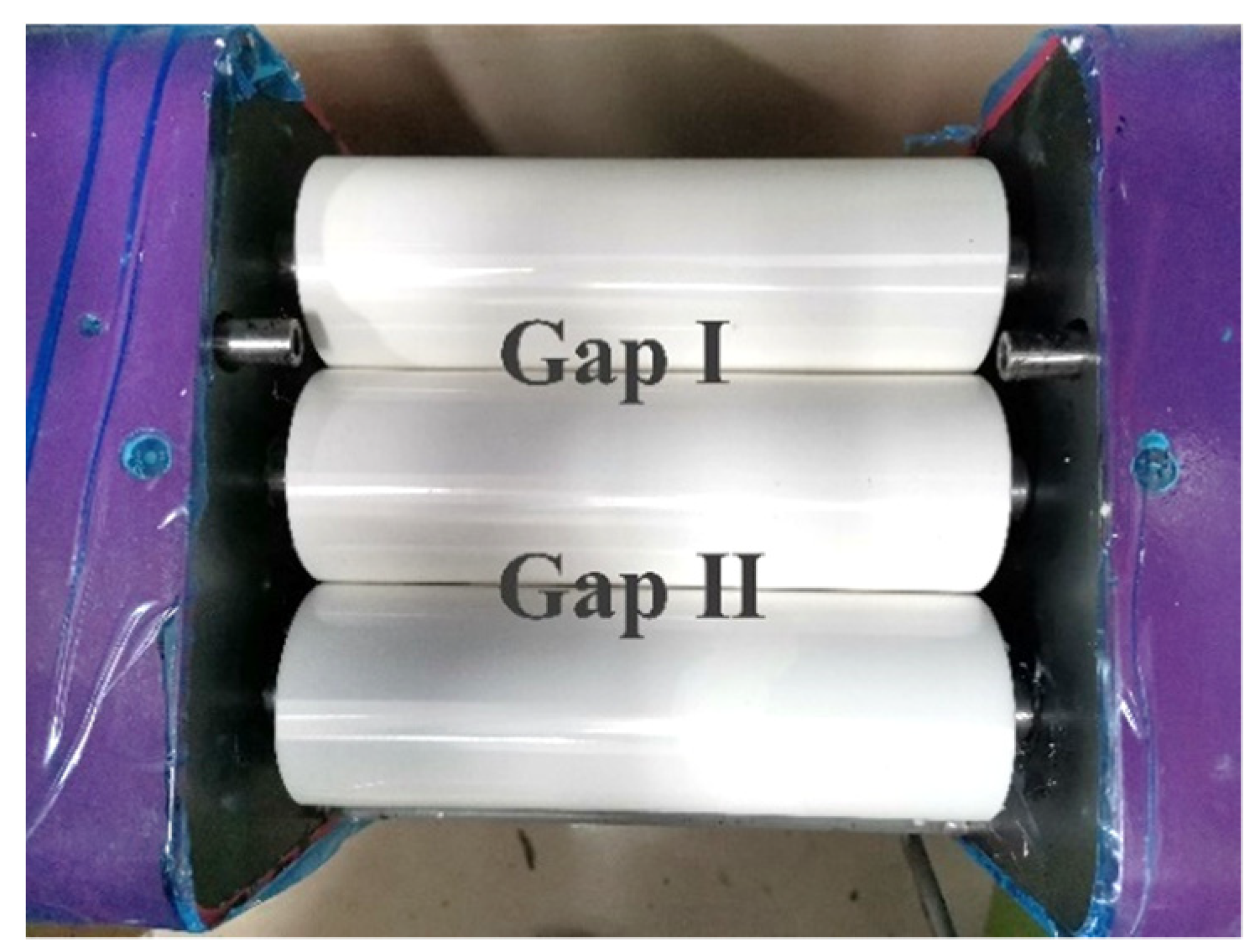
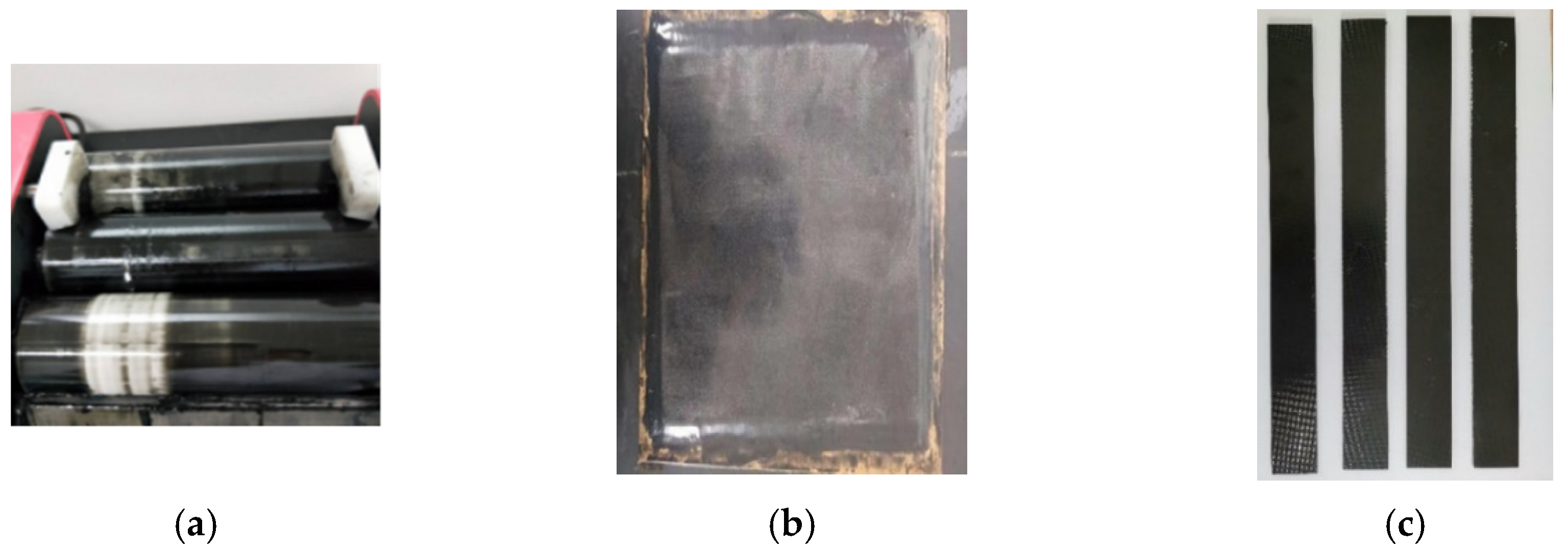
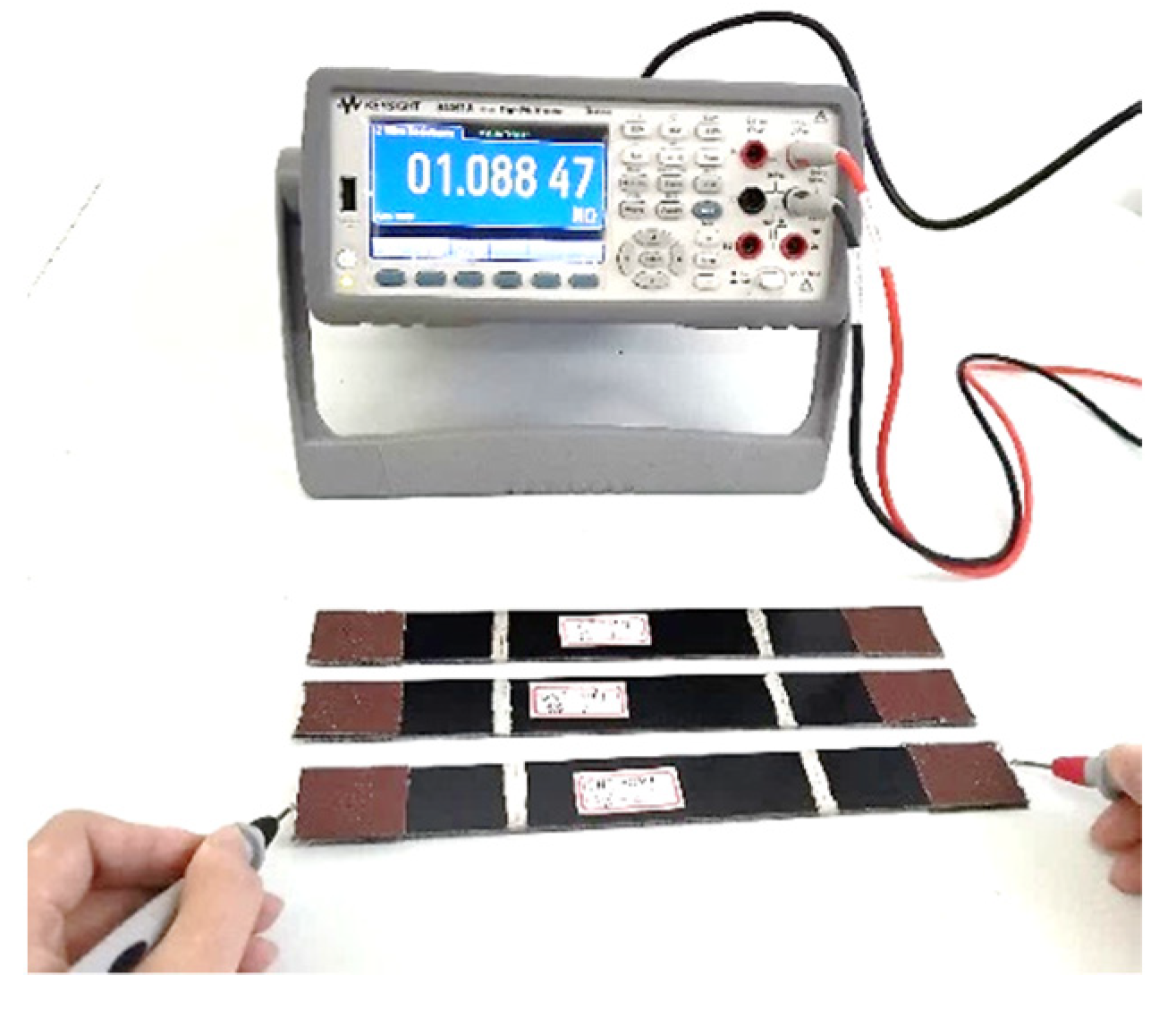

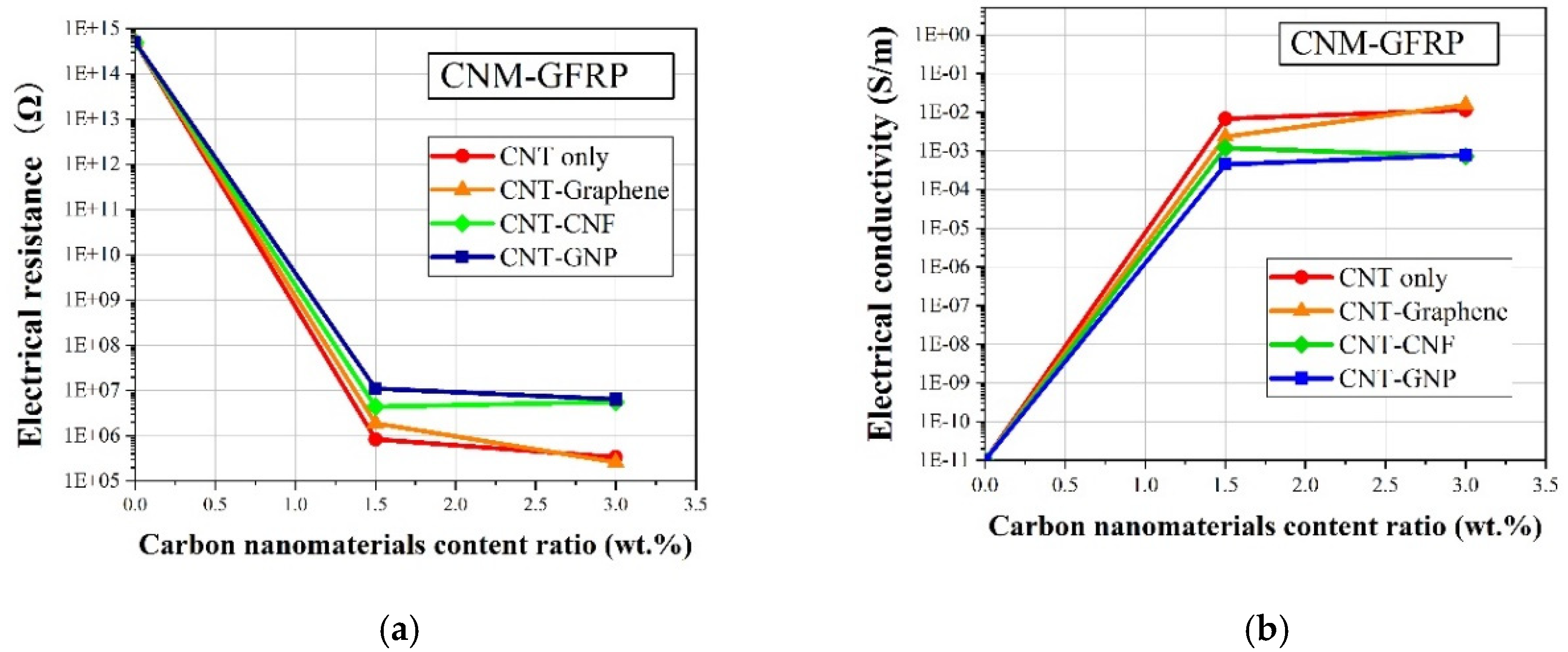
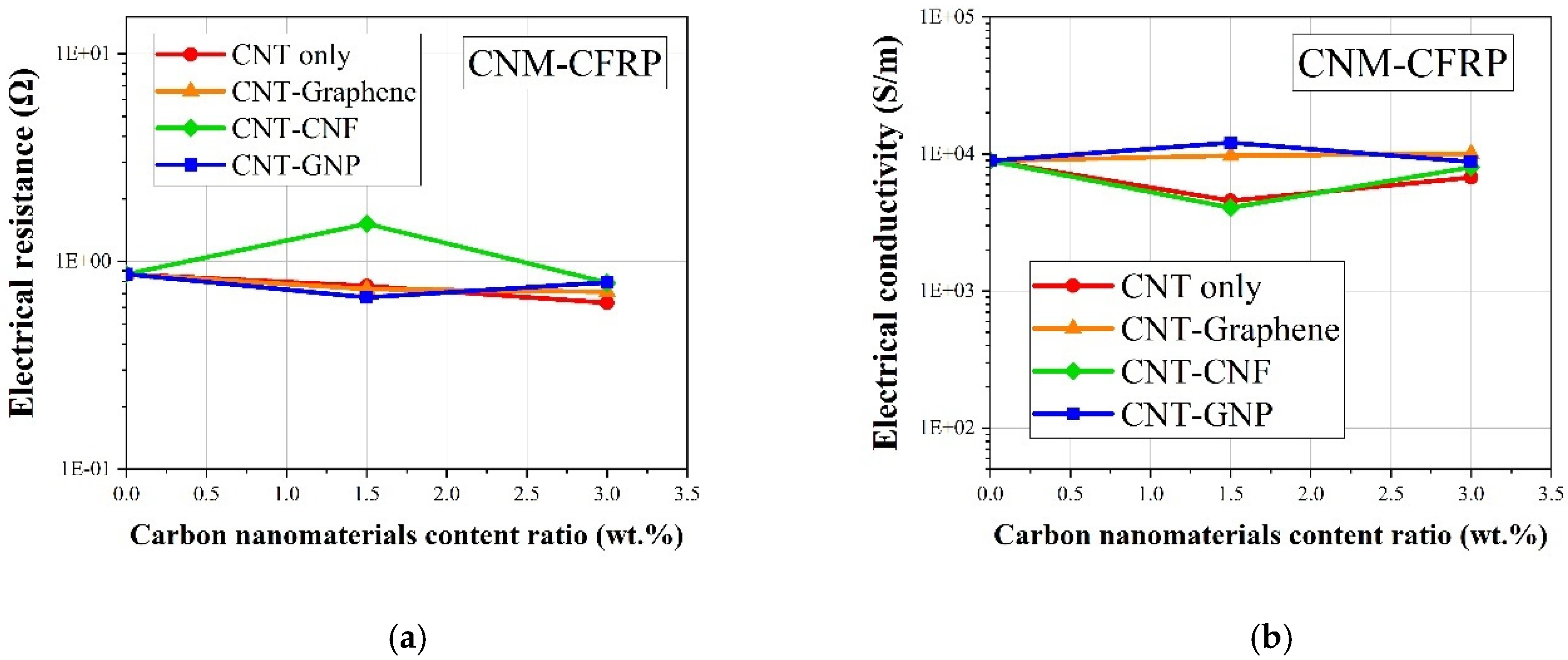

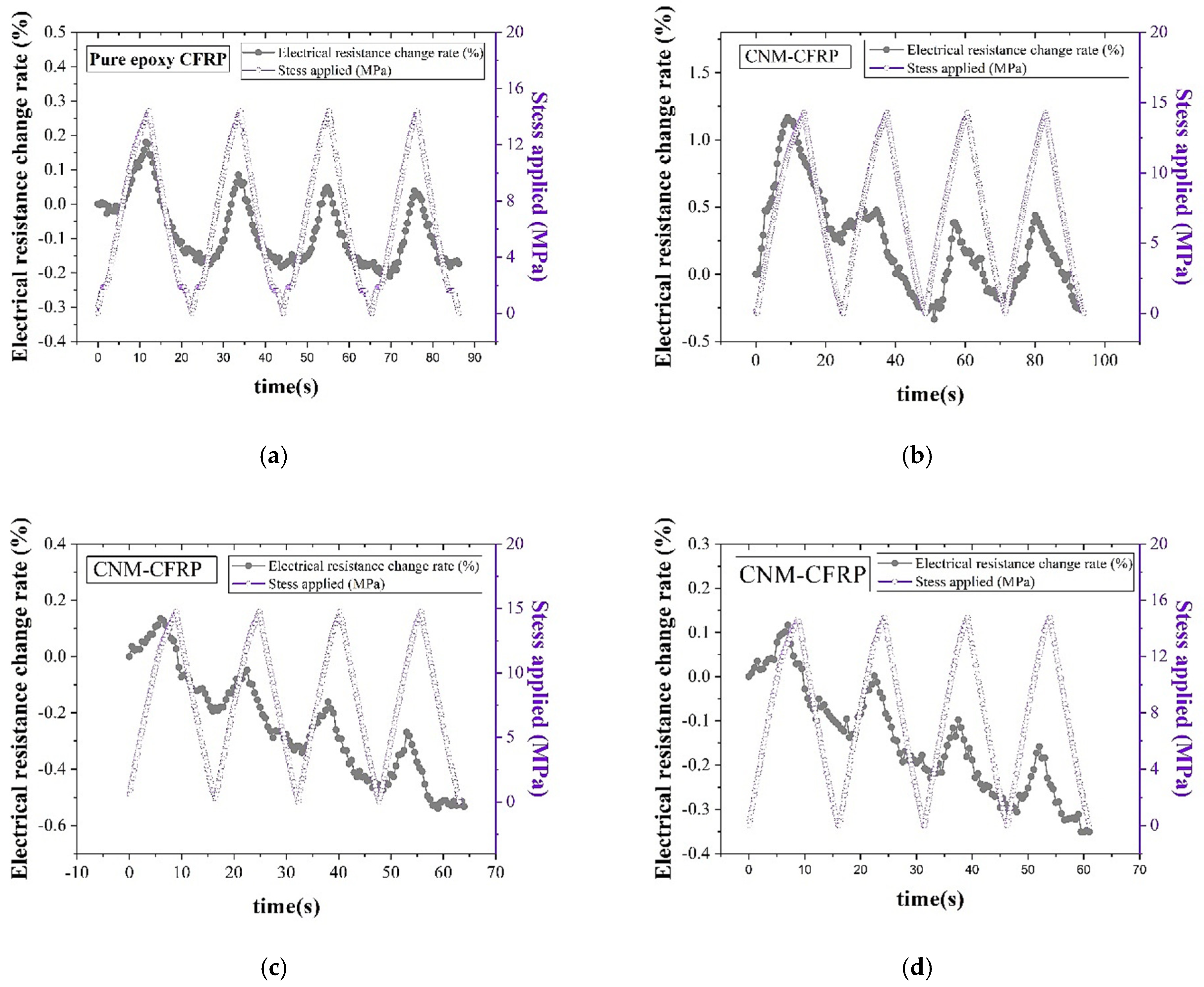

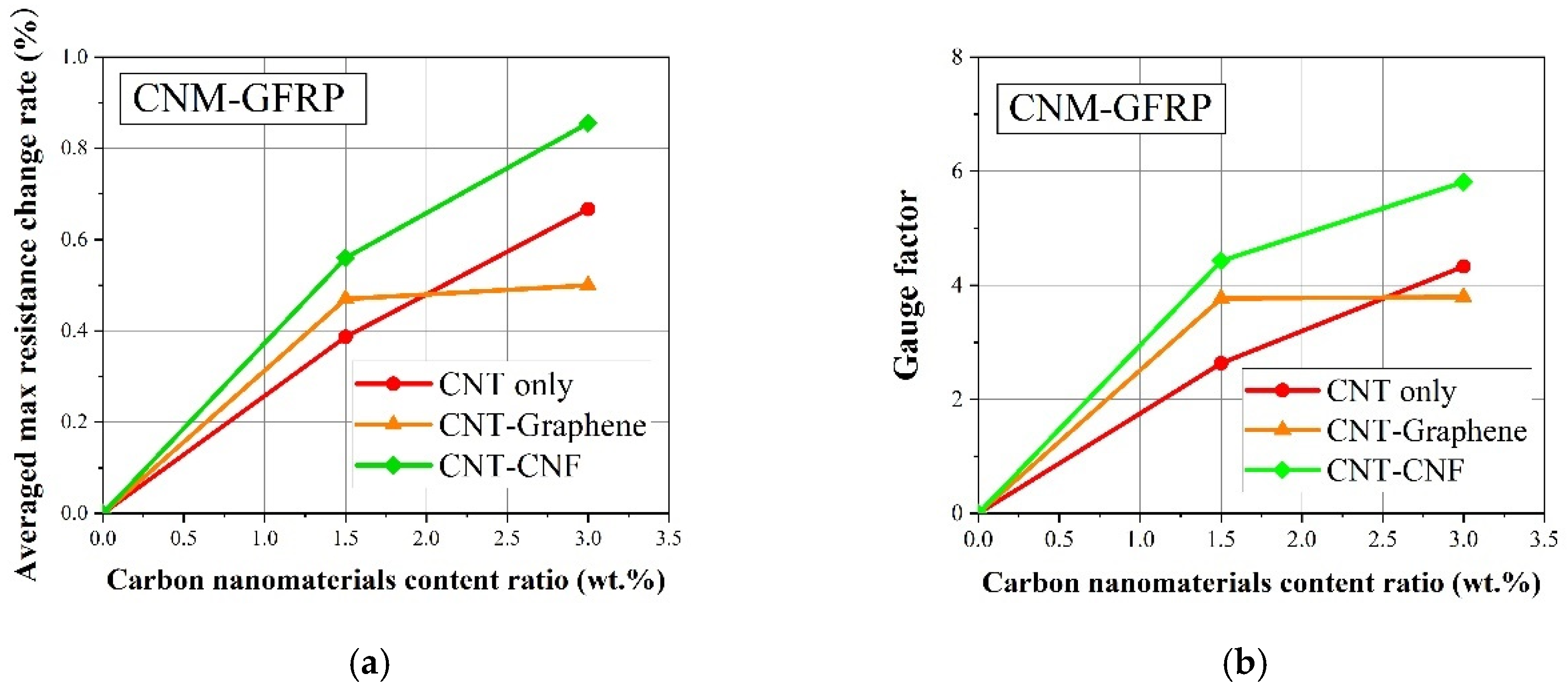

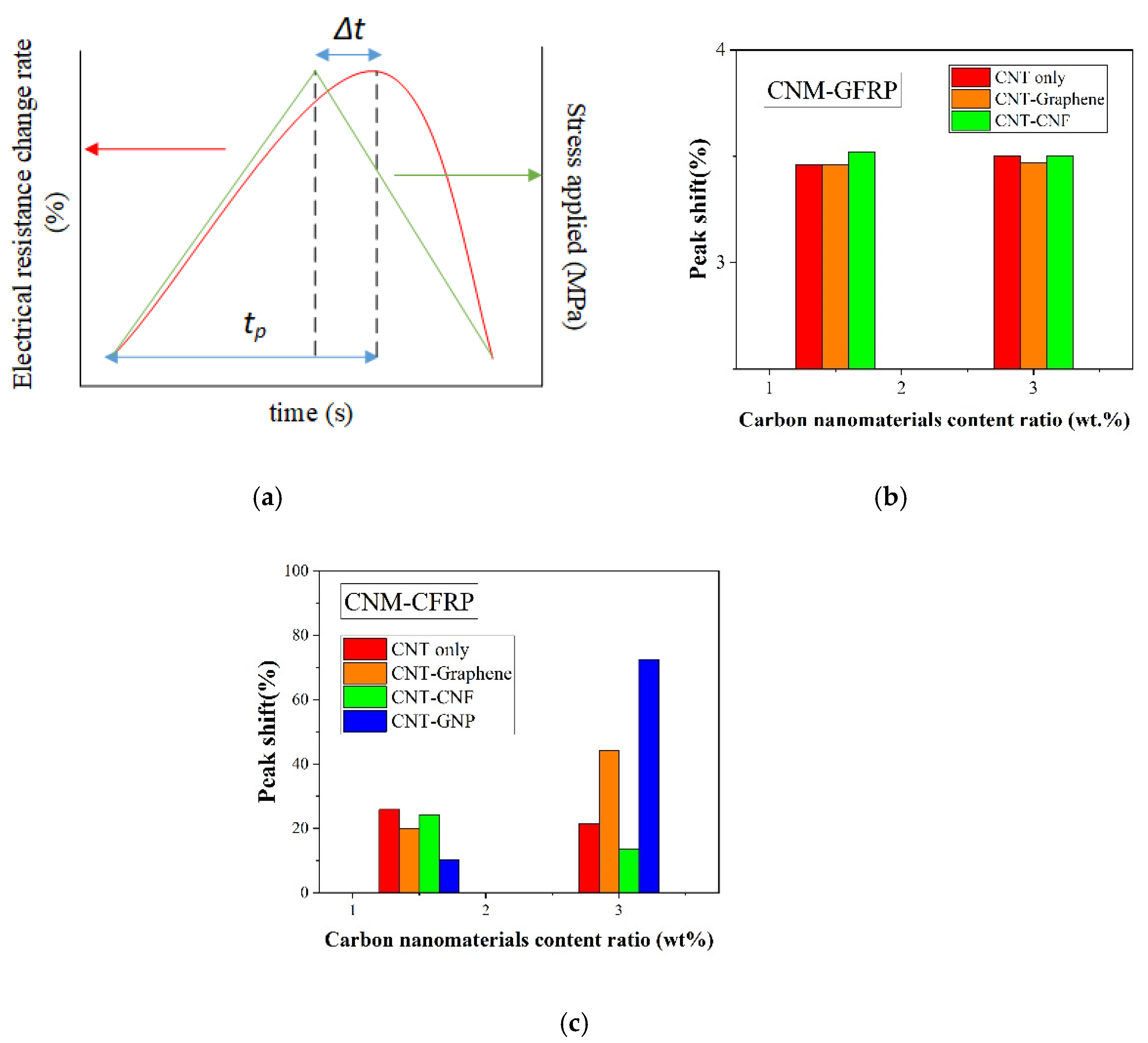


| Property | Carbon Nanotube | Graphene |
|---|---|---|
| Young’s modulus (TPa) | ~1.25 (SWNT) [25] ~0.27–0.95 (MWNT) [26] | 1 [27] |
| Tensile strength (Gpa) | ~13–52 (SWNT) [28] ~11–63 (MWNT) [26] | 130 [27] |
| Electrical conductivity (S·cm−1) | ~0.17–2 × 105 [29] | ~106 [30] |
| Thermal conductivity (W·m−1·K–1) | 6600 (SWNT) [31] 3000 (MWNT) [32] | ~3000–5000 [33] |
| Density (g/cm3) | 1.33 [34] | 2.2 [35] |
| Advantage in piezoresistivity | Tunneling effect (electron transfer without tube/tube contact) [10] | Relatively larger surface area in 2D, leading to an increase in contact probability [36] |
| Property | Epoxy Resin |
|---|---|
| Color | Colorless and transparent |
| Shrinkage rate (%) | <1 |
| Elongation (%) | ≈1.2 |
| Type of Fabric | Glass Fiber Plain Fabric | Carbon Fiber Plain Fabric |
|---|---|---|
| Grade (g) | 200, first level | 200, first level |
| Thickness (mm) | ≈0.12 | ≈0.11 |
| Elongation at break (%) | ≈3 | ≈3 |
| GFRP/CFRP Type | CNMs Weight (g) | Base Resin (g) | Hard- Ener (g) | Fiber Vol.% * |
|---|---|---|---|---|
| Pure epoxy GFRP/CFRP | 0 | 150 | 50 | 29.3%/50.8% |
| CNT-only GFRP/CFRP 1.5% | 3.05 | 150 | 50 | 32.4%/22.8% |
| CNT-only GFRP/CFRP 3% | 6.09 | 150 | 50 | 23.1%/28.1% |
| CNT–graphene GFRP/CFRP 1.5% | 1.525/1.525 | 150 | 50 | 26.7%/47.1% |
| CNT–graphene GFRP/CFRP 3% | 3.045/3.045 | 150 | 50 | 23.1%/41.3% |
| CNT–CNF GFRP/CFRP 1.5% | 1.525/1.525 | 150 | 50 | 30.0%/33.0% |
| CNT–CNF GFRP/CFRP 3% | 3.045/3.045 | 150 | 50 | 24.0%/41.3% |
| CNT–GNP GFRP/CFRP 1.5% | 1.525/1.525 | 150 | 50 | 29.3%/52.8% |
| CNT–GNP GFRP/CFRP 3% | 3.045/3.045 | 150 | 50 | 30.0%/45.5% |
| CNM Type | d (μm) | L (μm) | Excluded Volume (μm3) |
|---|---|---|---|
| CNT | 0.008 | 20 | 5.0 |
| Graphene | 1.75 | 6.6 | |
| CNF | 0.17 | 20 | 110.4 |
| GNP | 9 | 898.5 |
Publisher’s Note: MDPI stays neutral with regard to jurisdictional claims in published maps and institutional affiliations. |
© 2021 by the authors. Licensee MDPI, Basel, Switzerland. This article is an open access article distributed under the terms and conditions of the Creative Commons Attribution (CC BY) license (https://creativecommons.org/licenses/by/4.0/).
Share and Cite
Bhandari, M.; Wang, J.; Jang, D.; Nam, I.; Huang, B. A Comparative Study on the Electrical and Piezoresistive Sensing Characteristics of GFRP and CFRP Composites with Hybridized Incorporation of Carbon Nanotubes, Graphenes, Carbon Nanofibers, and Graphite Nanoplatelets. Sensors 2021, 21, 7291. https://doi.org/10.3390/s21217291
Bhandari M, Wang J, Jang D, Nam I, Huang B. A Comparative Study on the Electrical and Piezoresistive Sensing Characteristics of GFRP and CFRP Composites with Hybridized Incorporation of Carbon Nanotubes, Graphenes, Carbon Nanofibers, and Graphite Nanoplatelets. Sensors. 2021; 21(21):7291. https://doi.org/10.3390/s21217291
Chicago/Turabian StyleBhandari, Manan, Jianchao Wang, Daeik Jang, IlWoo Nam, and Baofeng Huang. 2021. "A Comparative Study on the Electrical and Piezoresistive Sensing Characteristics of GFRP and CFRP Composites with Hybridized Incorporation of Carbon Nanotubes, Graphenes, Carbon Nanofibers, and Graphite Nanoplatelets" Sensors 21, no. 21: 7291. https://doi.org/10.3390/s21217291
APA StyleBhandari, M., Wang, J., Jang, D., Nam, I., & Huang, B. (2021). A Comparative Study on the Electrical and Piezoresistive Sensing Characteristics of GFRP and CFRP Composites with Hybridized Incorporation of Carbon Nanotubes, Graphenes, Carbon Nanofibers, and Graphite Nanoplatelets. Sensors, 21(21), 7291. https://doi.org/10.3390/s21217291








